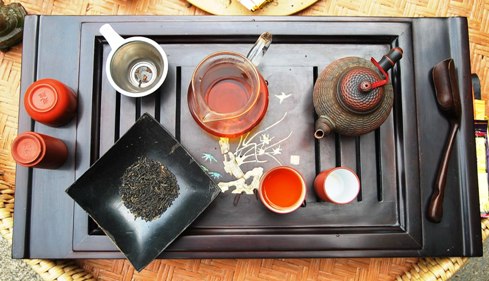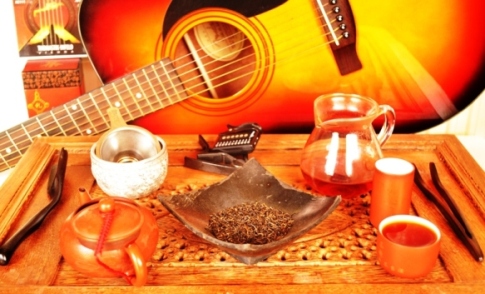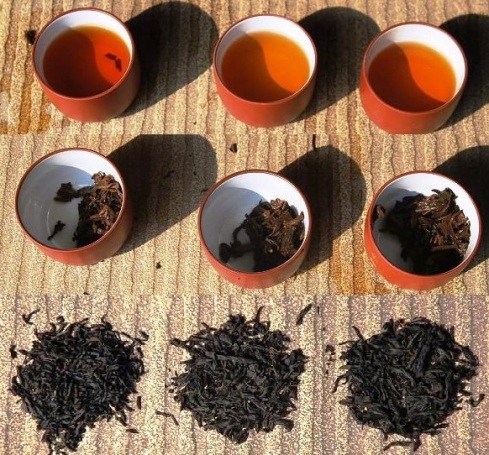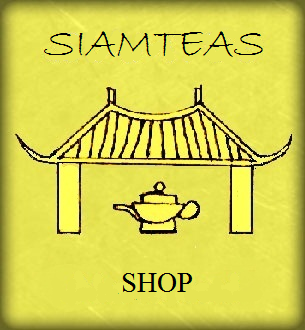Lapsang Souchong, Zheng Shan Xiao Zhong, Jin Jun Mei Tea – all the same?
Lapsang Souchong, Zheng Shan Xiao Zhong and Jin Jun Mei Tea – all the same?
Recently, in the context of the sampling process whose end was marked by the introduction of our Dian Hong Black & Golden Needle and the Bai Mu Dan White Tea into Siam Tea Shop, among others we had also tried a tea, whose package was labeled „Lapsang Souchong“. Inside the package, there were THREE GRAMS of a wild Lapsang Souchong, and the supplier had actually sent the sample along „just for fun“, and with the words „not always available, e.g. not currently, and when it is available, it will probably exceed a price that any of your customers might be willing to pay.” Well, then not…
 Wild Tongmu Lapsang Jin Jun Mei Tea
Wild Tongmu Lapsang Jin Jun Mei Tea
Of course, we would still – in a tiny circle and on an evening predestined for luxury – try and enjoy the said 3g-sample, which might best be described with the word „revelation“. The whole evening through and spanning at least 6 infusions we would revel in this tea, which we kept infusing even beyond the point, where it was actually done, only to prolong the fantastic aftertaste of this mind-conquering and soul-filling tea just a little more (this actually worked!). A miracle of harmonious balance between a high grade black tea and the smoky taste that is characteristic for Lapsang Souchong. But what did it help? It isn’t always available, it would not be available at all right now, and whenever it would be available, it would be unaffordable. However, the name, Lapsang Souchong, had branded itself into my memory on that evening and had never stopped spooking through my thoughts ever since, so I just couldn’t help myself but setting out to find out, whether there really wouldn’t be any Lapsang Souchong that would be available, affordable, and at least close to that we had tried that night. Besides the pending result of my ensuing efforts, which I soon will present at Siam Tea Shop, the pertaining research and degustations as usually brought about a specific basis of theoretical knowledge, which I would love to share here with the interested reader:
 Wild Tongmu Lapsang Jin Jun Mei tea: dry leaves & buds
Wild Tongmu Lapsang Jin Jun Mei tea: dry leaves & buds
Zheng Shan Xiao Zhong Tea
“Zheng Shan”, translated from Chinese, means about as much as „Original Mountain”. Meant are the Wuyi Mountains, and there in particular the area of „Tongmu“, and it also means that actually only Lapsang Souchong coming from that area, can be righteously referred to as Lapsang Souchong. Characteristic for all teas running under the main category Lapsang tea is the above-mentioned smoking of a black tea during its roasting and processing. However, what distincts one Lapsang from another, besides their taste resulting in a price spectrum ranging from dirt-cheap to unaffordable, is once the quality of the used tea, and second the material and method used for the smoking procedure, Then, third, meanwhile the actual origin might be counted amongst the distinction criteria as well. Today, “Zheng Shan Xiao Zhong” mostly refers to the best quality of classic Lapsang tea, i. e. in principle a Lapsang “Souchong” based on a high quality tea / high leaf grade.
 Lapsang Jin Jun Mei: wet leaves after infusion
Lapsang Jin Jun Mei: wet leaves after infusion
Classic Lapsang Souchong
Traditional, classic Lapsang Souchong used to be a tea produced from the lower parts of the tea plant („Souchong” = „fourth and fifth leave“), so an altogether minor quality, but accordingly cheap tea, whose rather unfavorable taste was both masked and complemented by means of an extended, 8-hours lasting smoking process, in order to make this low quality tea still attractive and marketable. In fact, it is said that though Lapsang Souchong tea used to enjoy quite a high popularity in the west, the Chinese themselves rather considered it as a “Poor-Man’s-Tea”. The tendentiously strong smoking traditionally is done on a fire made from fresh cut pine wood, this giving the classical Lapsang Souchong its typical taste.
Lapsang Jin Jun Mei
The idea to produce a much higher quality „Lapsang“ by using a much higher grade tea (1 bud + 1 most upper leaf or 1 bud + 2 most upper leaves) on the one hand, and smoking it in a much more gentle way on a fire made from well-aged, completely dry pine wood (instead of the fresh-cut one used or the „Souchong“) and for a shorter period, has only been developed after the most recent millennium change. This new Lapsang tea, called “Jin Jun Mei“ has ever since continued to climb up the scale of popularity both in China itself and outside of China, i.e. in Europe, the USA, etc. Climbed up the scale, however, have also the prices for this tea, which clearly can no longer be called a “Poor-Man’s- Tea” now.
Lapsang Tongmu
As already mentioned above, the area of Tongmu is the cradle and the traditional cultivation area for the Lapsang Souchong tea. However, as Tongmu today is a UNESCO protected area and so small in terrain that the production of the classic Lapsang Souchong is not considered as worthwhile there anymore today, the tea producers o Tongmu have readily jumped on the new trend train and by now are producing nearly exclusively Lapsang Jin Jun Mei, as this will score significantly higher prices, while the classical Lapsang Souchong ever more often does not even come from Tongmu anymore, but instead from surrounding areas, from where the tea is merely brought for smoking to Tongmu.
What this means for us
Now, first of all, this meant for us the realization that it had never been „Lapsang Souchong“ tea in the most narrrow sense that we had been looking for in the first place, but rather „Lapsang Jin Jun Mei“ Tea and Lapsang Zheng Shan Xiao Zhong (or together „Lapsang Tongmu“, which would relate to a somewhat wider understanding). Initially, we had tried a whole range of “Lapsangs“ without having the slightest clue of the above-mentioned origins, backgrounds, differentiations and developments, and indeed: in retrospect we could see that the cheaper classic Lapsang Souchongs had fallen through the cracks already at a very early stage of our degustations, while the frontrunners that have meanwhile qualified to be part of our final choice, were in fact Lapsang Jin Jun Mei and Zheng Shan Xiao Zhong teas. Nevertheless, with our studies of online and other sources it came to our attention that also high grade and expensive Lapsangs are still often referred to as Lapsang Souchong by traders, probably simply due to the higher fluency of this term among tea drinkers.
We’ve got an excellent Lapsang Zheng Shan Xiao Zhong for you to try at Siam Tea Shop now! You will find more information and illustration on our relevant product page by clicking on the following link:












Pingback : Long Jing “Dragonwell” Green Tea – Authentic & Wild